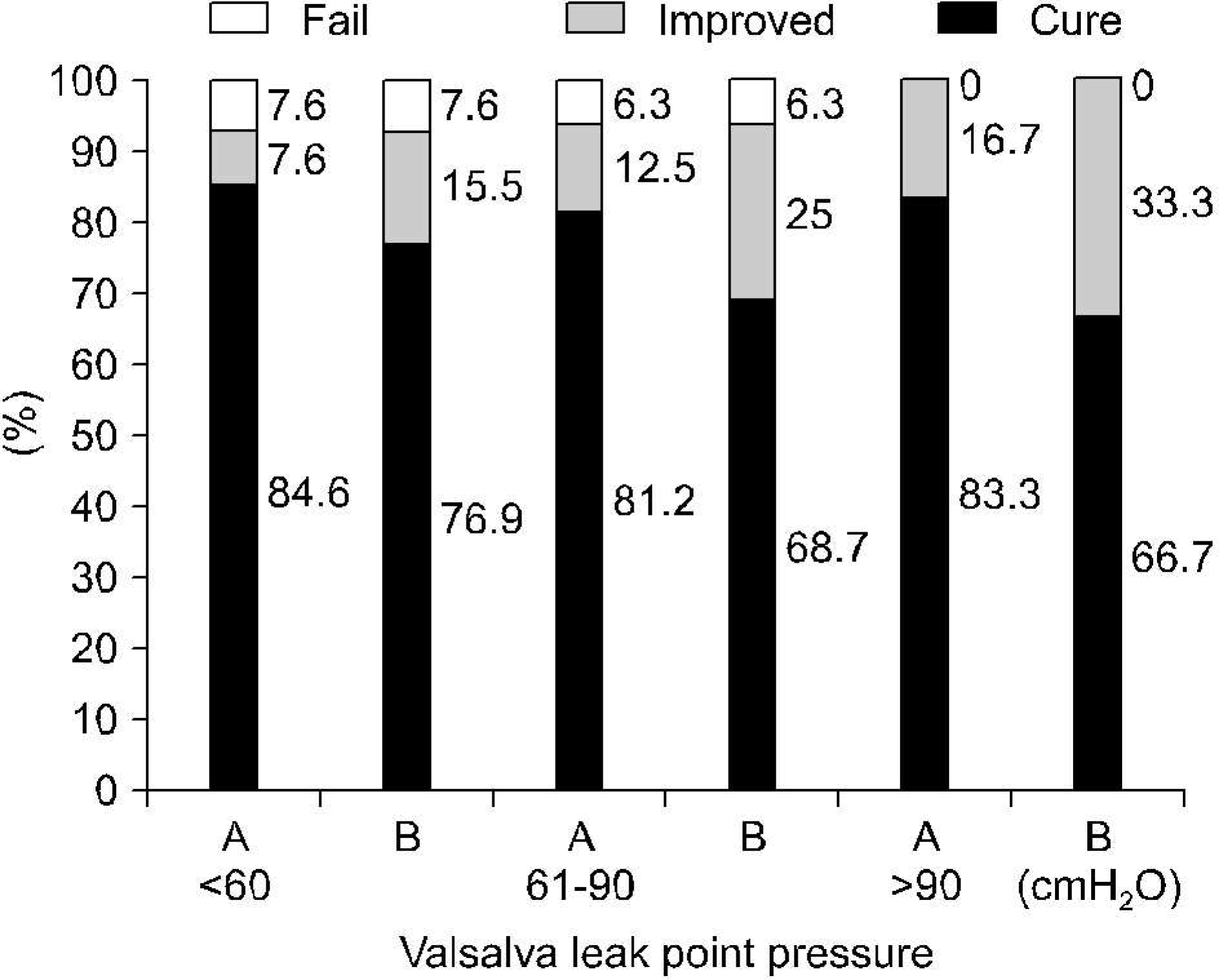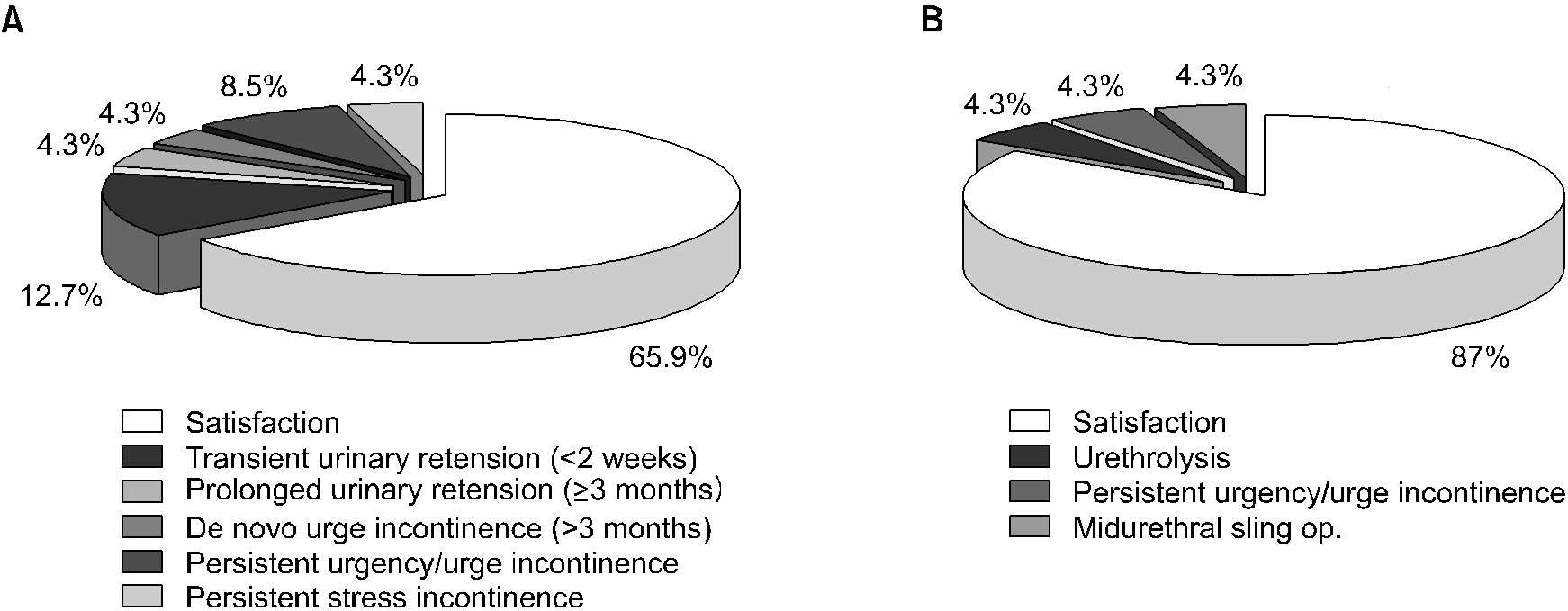Abstract
Purpose:
lunHH The long term results of pubovaginal fascial sling surgery were evaluated in female stress urinary incontinence (SUI), and were compared with concomitant surgery in pelvic organ prolapse.
MMMMB βλ MMnAl
A total of 47 SUI patients were treated with pubovaginal fascial sling surgery between 1997 and 2000. A satisfaction evaluation and success grading of the operation were studied. A postoperative evaluation was performed via a survey questionnaire, uroflow- metry and post-void residuals.
Results:
RHuHH Forty-five patients (95.7%) showed successful results at the 2- & 5-year follow-ups, but 2 patients (4.3%) railed. There were no significant differences in success rates according to Valsalva leak point pressure (VLPP) and the pelvic organ prolapse surgery. Thirty-one patients (66.0%) were satisfied with their result, while 16 (34.0%) were unsatisfied at the 2-year follow up. Those unsatisfied with the result included 8 with a urethral obstruction, 6 with urge incontinence and 2 with persistent SUI. Two patients with prolonged urinary retention had undergone urethrolysis. Postoperative de novo and persistent urge incontinence occurred in 2 and 4 patients, respectively. Two patients with persistent SUI were cured using the midurethral sling. Finally, forty-one patients (87.2%) were satisfied with the results, while 6 (12.8%) were unsatisfied at the 5-year follow-up.
Conclusions:
The 5-year follow-up results of the pubovaginal fascial sling surgery showed a high success rate and relatively good results with respect to satisfaction with the procedure. If a urethral obstruction and urge incontinence are treated carefully, sling surgery can be considered as an efficient method for any type of urinary incontinence.
Go to : 
REFERENCES
1.Blaivas JG., Romanzi LJ., Heritz DM. Urinary incontinence: pathophysiology, evaluation, treatment overview and non-surgical management. Walsh PC, Retik AB, Vaughan ED, Wein AJ, editors. editors.Campbell' s urology. 7th ed.Philadelphia: Saunders;1998. p. 1007–43.
2.Leach GE., Dmochowski RR., Appell RA., Blaivas JG., Hadley HR., Luber KM, et al. Female stress urinary incontinence clinical guidelines panel summary report on surgical management of female stress urinary incontinence. J Urol. 1997. 158:875–80.

3.Kelly MJ., Knielsen K., Bruskewitz R., Roskamp D., Leach GE. Symptom analysis of patients undergoing modified Pereyra bladder neck suspension for stress urinary incontinence. Pre-postoperative findings. Urology. 1991. 37:213–9.
4.Appell RA. Argument for sling surgery to replace bladder suspension for stress urinary incontinence. Urology. 2000. 56:360–3.

5.Raz S., Sussman EM., Erikson DB., Bregg KJ., Nitti VW. The Raz bladder neck suspension: results in 206 patients. J Urol. 1992. 148:845–50.

6.Trockman BA., Leach GE., Hamilton J., Sakamoto M., Santiago L., Zimmen PE. Modified Pereyra bladder neck suspension: 10-year mean folbw up using outcomes analysis in 125 patients. J Urol. 1995. 154:1841–7.
7.Haab F., Zimmem PE., Leach GE. Female urinary stress incontinence due to intrinsic sphincteric deficiency: recognition and management. J Urol. 1996. 156:3–17.
8.Wahle GR., Young GP., Raz S. Vaginal surgery for stress urinary incontinence. Urology. 1994. 43:416–9.

9.Zaragoza MR. Expanded indications for the pubovaginal sling: treatment of type 2 or 3 stress incontinence. J Urol. 1996. 156:1620–2.

10.Cross CA., Cespedes RD., McGuire EJ. Our experience with pubovaginal slings in patients with stress urinary incontinence. J Urol. 1998. 159:1195–8.

11.Raz S., Erickson DR. SEAPI QMM incontinence classification system. Neurourol Urodyn. 1992. 11:187–99.

13.Kohor EL The surgery of stress urinary incontinence. Obstet Gynecol Clin North Am. 1989. 16:841–52.
14.McGuire EJ., Lytton B. Pubovaginal sling procedure for stress incontinence. J Urol. 1978. 119:82–4.

15.McGuire EJ., Bennett CJ., Konnak JA., Sonda LP., Savastano JA. Experience with pubovaginal slings for urinary incontinence at the University of Michigan. J Urol. 1987. 138:525–6.

16.Appell RA., Goldman HB., Rockley RR. Efficacy and predictors of sucess for the in situ anterior vaginal wall sling with bone anchoring. J Urol. 1998. 160((Suppl):):159–324. abstract. 1245.
17.Palma PC., Riccetto CL., Herman V., Santos JF., Lucena R., Netto NR Jr, et al. Is vaginal wall sling a good option for intrinsic sphincter deficiency. J Urol. 1998. 159:1245.
18.Chaikin DC., Rosenthal J., Blaivas JG. Pubovaginal fascial sling for all types of stress urinary incontinence: long-term analysis. J Urol. 1998. 160:1312–6.

19.Lee JB., Park WH., Lee YS., Seo JT., Park SS., Kim HY, et al. The long term outcome of fascial sling operation in female stress urinary incontinence: multicenter study in Korea. Korean J Urol. 2005. 46:950–5.
20.Carr LK., Walsh PJ., Abraham VE., Webster GD. Favorable outcome of pubovaginal slings for geriatric women with stress incontinence. J Urol. 1997. 157:125–8.

21.Stanton SL., Cardozo L., Chaudhury N. Spontaneous voiding after surgery for urinary incontinence. Br J Obstet Gynaecol. 1978. 85:149–52.

22.Lee RA., Symmonds RE., Goldstein RA. Surgical complications and results of modified Marshall-Marchetti-Krantz procedure for urinary incontinence. Obstet Gynecol. 1979. 53:447–50.
23.Haab F., Trockman BA., Philippe Em., Zinmmem PE., Leach GE. Results of pubovaginal sling for the treatment of intrinsic sphicter deficiency determined by questionnaire analysis. J Urol. 1997. 158:1738–41.
24.Fulford SC., Flynn R., Barrington J., Appanna T., Stephenson TP. An assessment of die surgical outcome and urodynamic effects of th pubovaginal sling for stress incontinence and the associated urge syndrome. J Urol. 1999. 162:135–7.
25.Hassouna ME., Ghoniem GM. Long-term outcome and quality of life after modified pubovaginal sling for intrinsic sphincteric deficiency. Urology. 1999. 53:287–91.

26.Park YJ., Yoon SJ., Lee JB. The effectiveness and satisfaction of modified fascial sling in patients with stress urinary incontinence: comparison between simple and complex types. Korean J Urol. 2002. 43:759–63.
Go to : 
 | Fig. 1.Surgical outcomes of pubovaginal fascial sling (A: 2-year f/u, B: 5-year f/u). ∗chi-square test: Linear-by-Linear association: 0.282 (2-year, 5-year). |
 | Fig. 2.The rates of satisfaction and dissatisfaction, and the causes of dissatisfaction (A: 2-year f/u, B: 5-year f/u). |
Table 1.
Preoperative characteristics of the forty-seven patients
Table 2.
Comparison of the voiding parameter according to combined prolapse surgery
Table 3.
Comparison of the preoperative and postoperative (2- & 5-year follow-ups) subjective SEAPI scores




 PDF
PDF ePub
ePub Citation
Citation Print
Print


 XML Download
XML Download